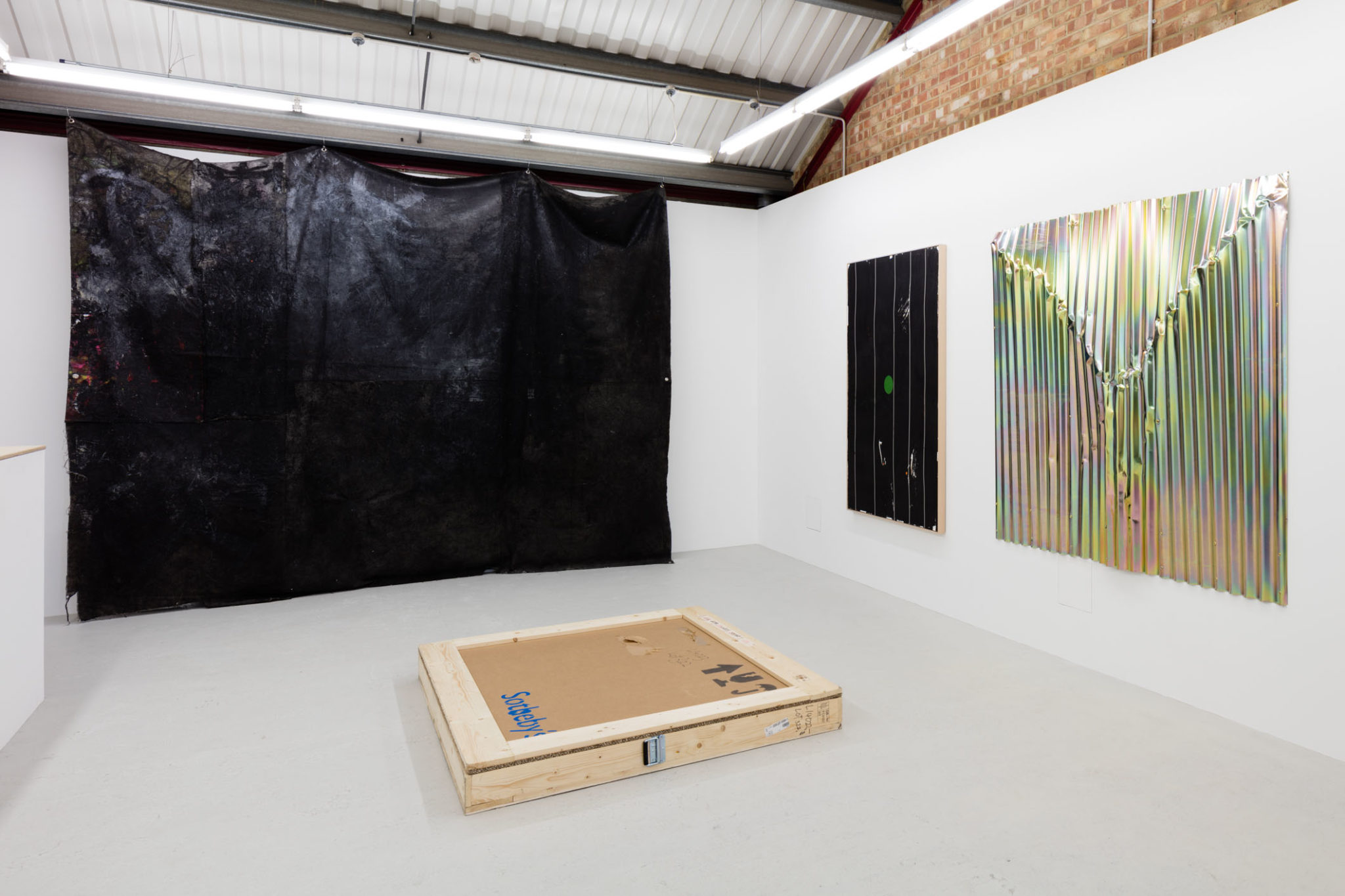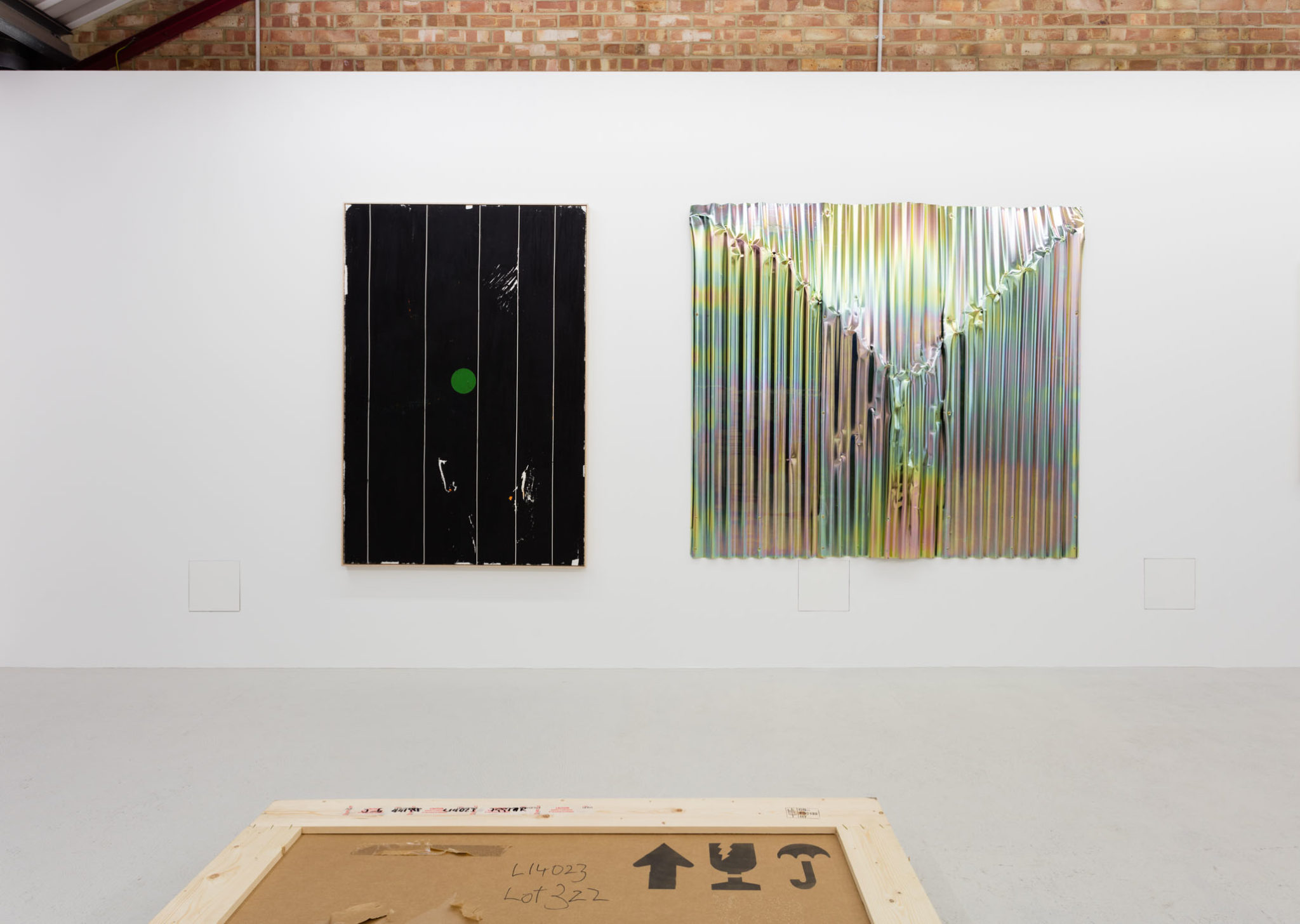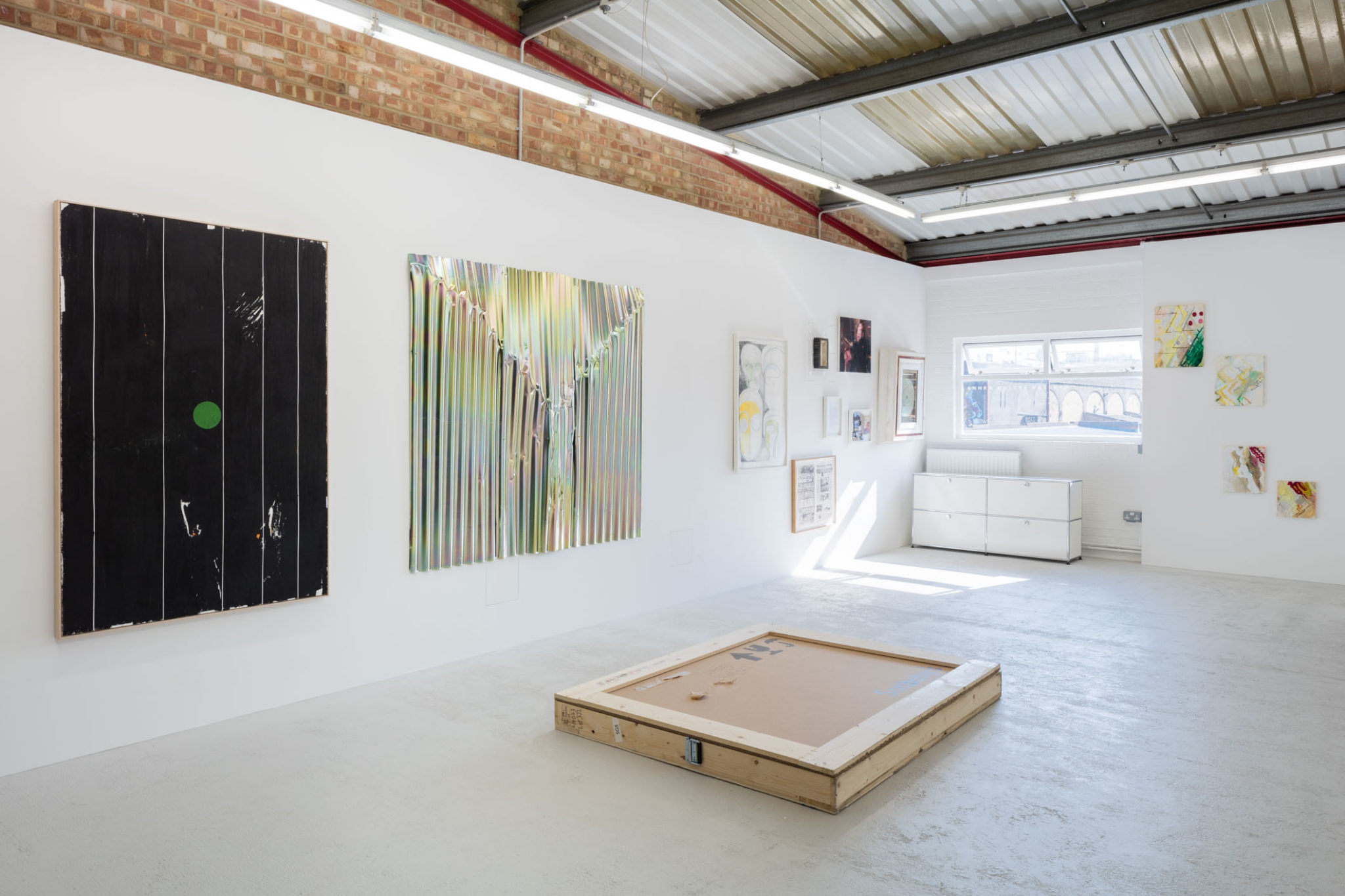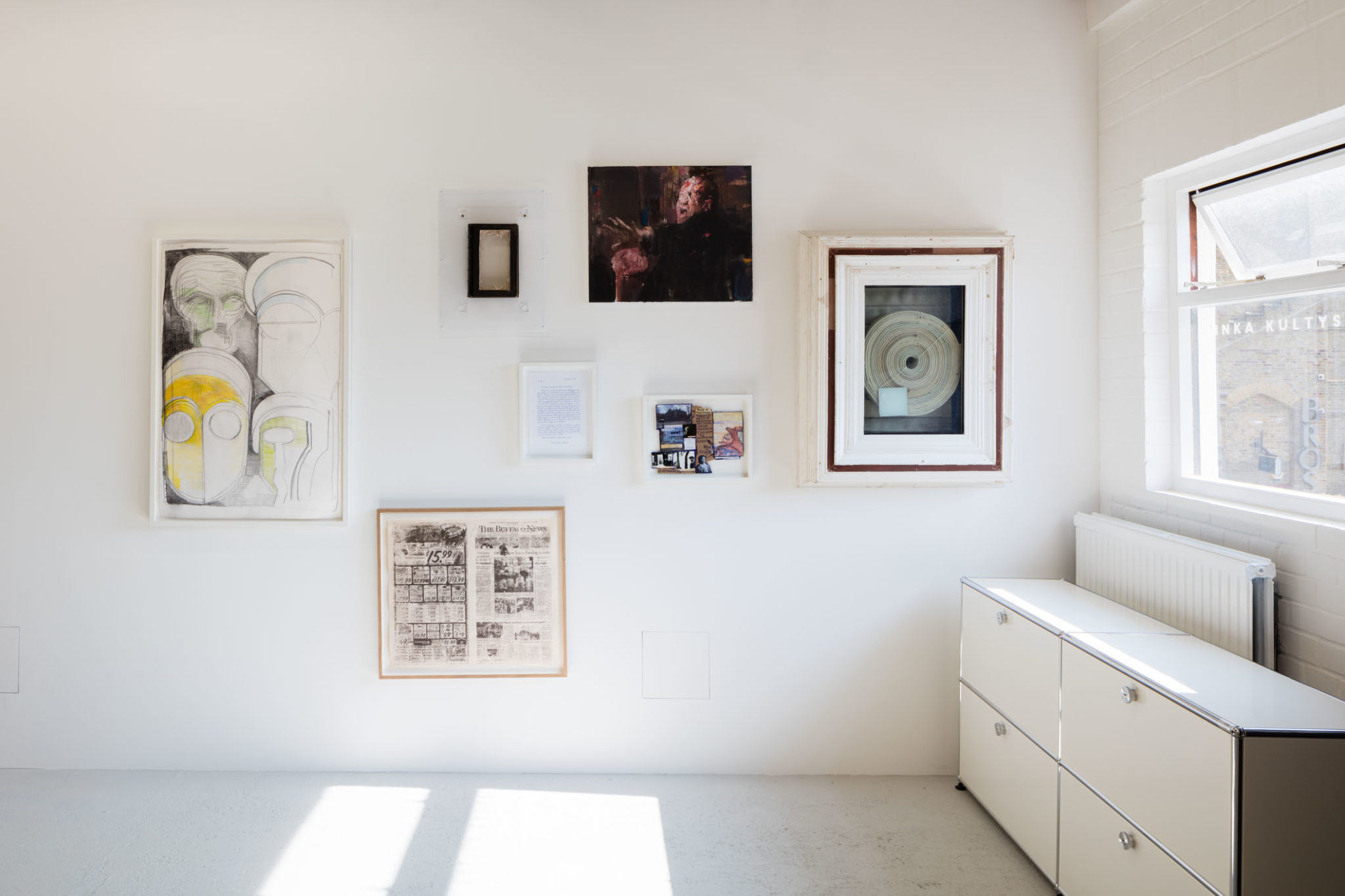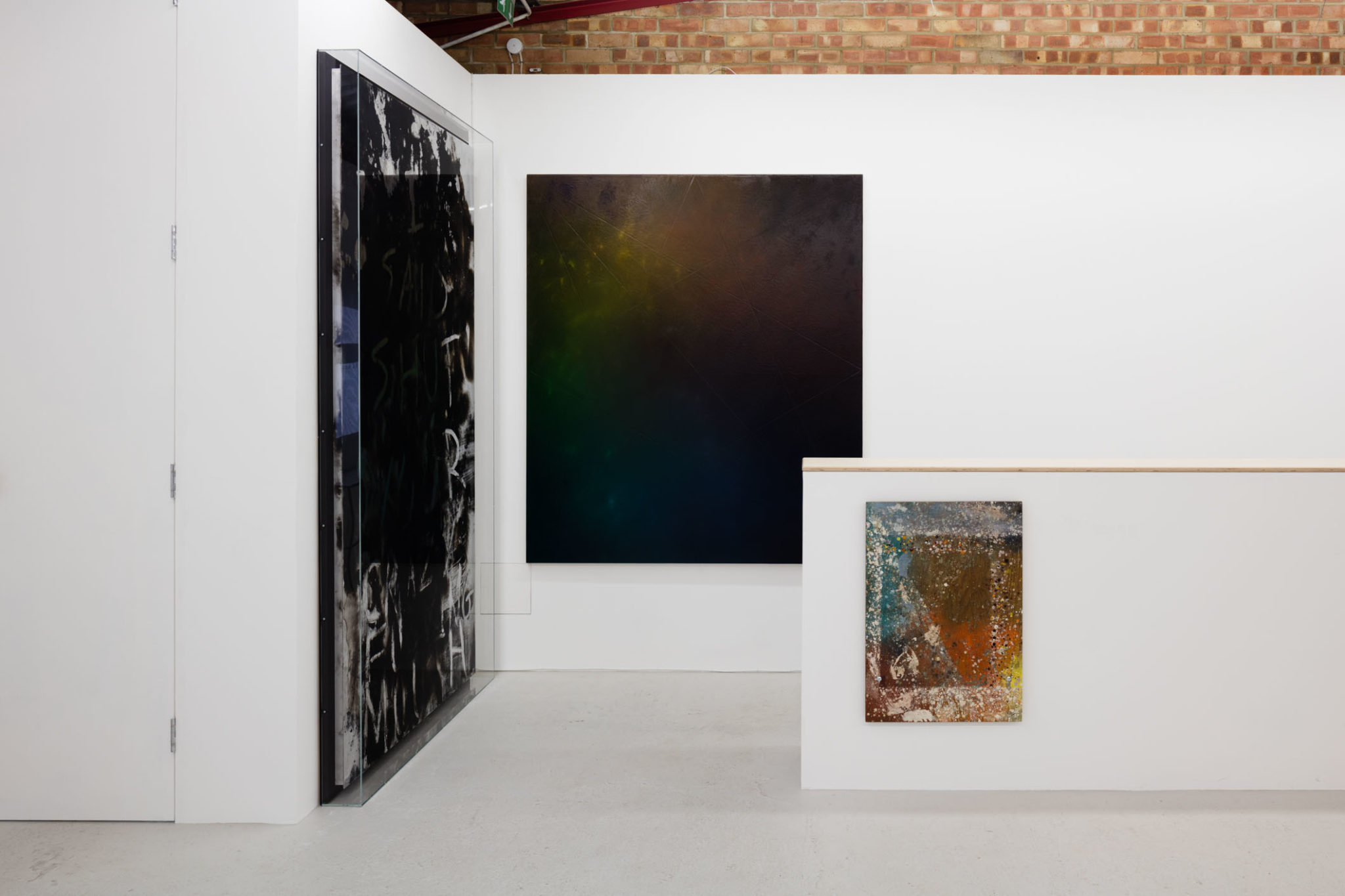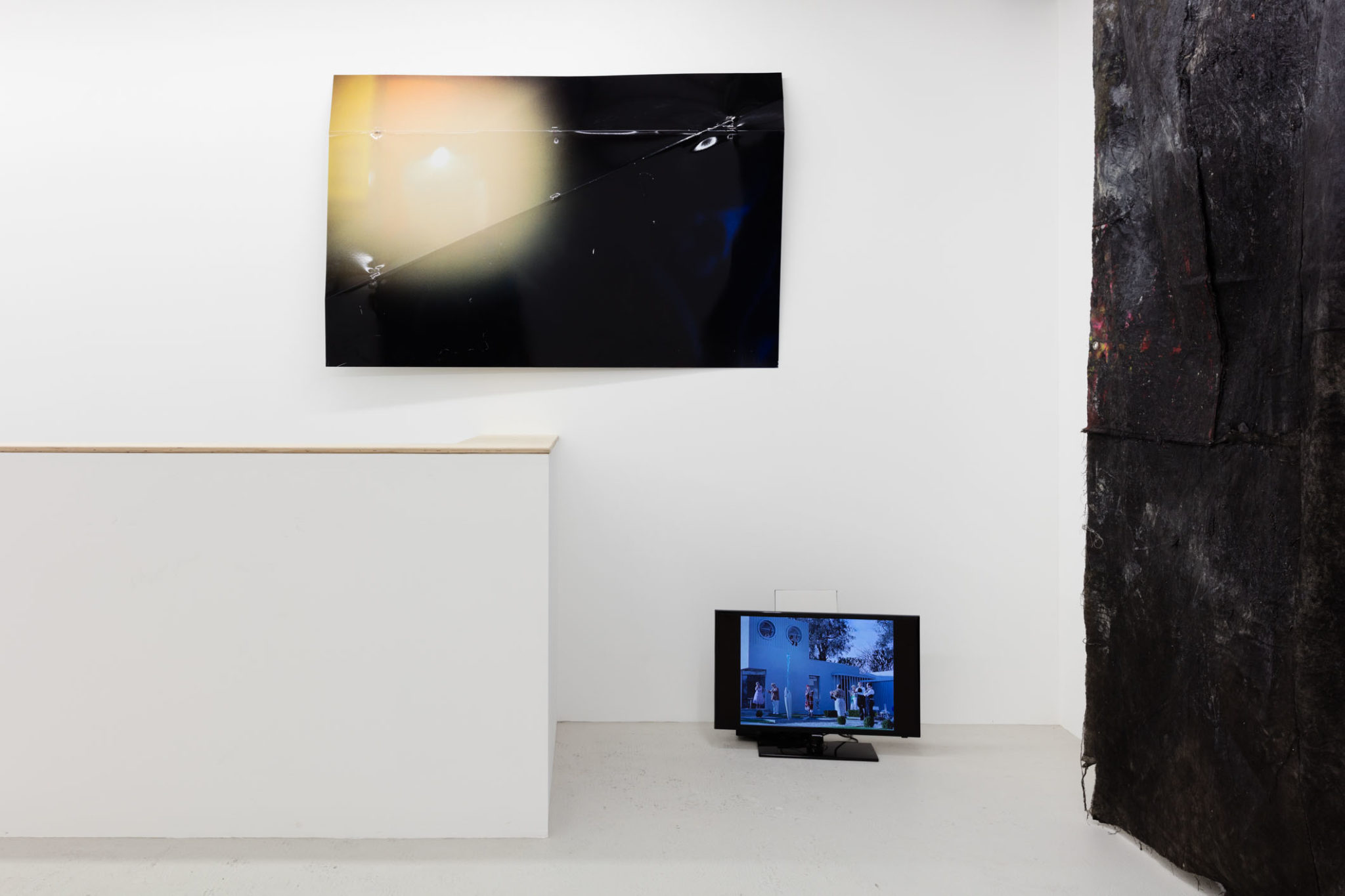
On the occasion of the exhibition, the gallery is publishing a catalogue to accompany the exhibition including essays by John Brennan and Sherman Sam, and photographs of installation views.
CHOOSE ART
BY JOHN BRENNAN
Choose Art. Choose the lifestyle. Choose the pastime. Choose the fucking big paintings. Choose art magazines, artists’ monographs and limited edition tote bags. Choose parties, VIP treatment and private jets. Choose a collection. Choose an art consultant. Choose a leading contemporary gallery in major cities around the world. Choose cultural criticism, the creation of meaning and savoir-faire.
Choose a warehouse space. Choose your friends. Choose haute couture and matching luggage. Choose an interior designer and a range of iconic furniture pieces. Choose biennials, art fairs and Documentas. Choose unintelligible, jargon-filled press releases written by intellectual amoeba.
Choose mind-numbing, spirit-crushing gallery openings. Choose watching scenesters gossip and gorge while studiously ignoring the art on show. Choose private dinners cornered by insufferable sales reptiles. Choose sitting in your warehouse space surrounded by your art wondering who you are every evening.
Choose to exhibit your impeccable taste. Choose philanthropy, public service and social cache. Choose immortality by launching your own art space, foundation or private museum.
Choose your future.
Choose art…
But why would you want to do a thing like that?
Why indeed? John Hodge’s opening monologue from the 1996 screen adaptation of Irvine Walsh’s Trainspotting, to which the foregoing owes its structure, was a scathing indictment of the vacuousness of early nineties consumerism and the empty choices that accompanied it.[i] With but minimal alteration Hodge’s form melds easily to critique many of the less palatable aspects of today’s contemporary art world. Accusations that the art world is beholden to a powerful clique of the super-rich; that it is now but an outpost of the frivolous, party-fied, international fashion industry; that art writing has become incomprehensible, irrelevant and, more damningly, just plain old dull; that what masquerades as criticism is but mere puffery for sales processes; and that there is now so much money sloshing around the contemporary art scene, there are so many vested interests being pandered to, that any hope of considered, objective evaluation of contemporary art is now out of the question.
Yet if this is so, then how did this happen? What choices led to this point and, indeed, who has been making those choices? Because choice lies at the core of most of these issues. Choices such as: Which artists get to be exhibited? What art becomes valued in the contemporary art world? Where do the works get shown? Who buys the work? And for how much? Grayson Perry, the contemporary potter and neophyte cultural commentator, in both his recent book and his popular Reith lecture series for BBC Radio, conflated such issues under the rubric of quality. Perry noted ‘the question of quality is one of the most burning issues around art: how do we tell if something is good? What are the criteria by which we judge art made today, and who tells us that it’s good? That perhaps is even more important.’[ii] Verily, the ‘who’ is probably the most interesting of all these issues.
Annka Kultys Gallery’s inaugural exhibition, Desire of the Other, is a meditation on such questions; on such choices and particularly on the role art collectors presently play in answering those questions. It is a group show that contains some of the hottest, i.e., collectors’ most sought after, most valuable, if not perhaps valued, artists of the moment. Names like Oscar Murillo, Kaari Upson, Oscar Tuazon and Frederik Vaerslev, works by all of whom are on show in the exhibition, are examples of artists who presently enjoy strong support from super-collectors (key private collectors with considerable financial resources and the concomitant influence in the art world). As a result, amid frenzied art collector focus, such artists have received rapturous acclaim from the market.
Oscar Murillo epitomises the phenomenon better than most. Graduating from the Royal College of Art in London with his MFA in 2012, works of the young Colombian-British artist were selling for in excess of a quarter of a million pounds (GBP 250,000) by the summer of 2013, exceeding estimates and previous records by a quite remarkable factor of up to ten times.[iii] The explanation for such a remarkable escalation in prices paid for the artists work? Well perhaps his residency at the Rubell Family Collection in Miami, following an adrenalin-fuelled first encounter with the super-collectors, Donald and Mera Rubell, where he produced an eye-raising nine major works in one 36-hour period to impress them, may have had something to do with it. The ensuing tie-up with the peripatetic curator Hans Ulrich Obrist, the obligatory fashion tie-up with Comme de Garcons and the subsequent move to mega-gallery, David Zwirner, would no doubt also have played a part, but the overwhelming impression was that Murillo’s coronation as one of the hottest artists of the moment was facilitated by the Rubells and the influence of their private collection.
The nineties and early millennium have witnessed a proliferation of collectors opening private museums, often on scales to rival their more illustrious public counterparts, as a means to bring their art collections to the viewing public. To Donald and Mera Rubell’s Rubell Family Collection, one can add the private museums of super-collectors such as François Pinault, the French billionaire and owner of brands such as Gucci and Chateau Latour with his Palazzo Grassi Foundation in Venice; Charles Saatchi, the British advertising magnate and his Saatchi Gallery in London; Baron and Baroness Guy and Myriam Ullens de Schooten and the UCCA (the Ullens Center for Contemporary Art) in Beijing; and Eli and Edythe Broad with their brand new contemporary art museum in downtown Los Angelos, The Broad, the official opening of which in California will coincide with Desire of the Other.
So what should be made of the meteoric rise in the prices paid for emerging artists’ work, work like Murillo’s, following interest from super-collectors? The question really boils down to whether the market can be relied upon as an arbiter of artistic quality. The painter of masterpieces such as Bal du moulin de la Galette (Dance at the Le Moulin de la Galette, 1876) and Le dejeneur de canotiers (Luncheon of the Boating Party, 1880-1), the impressionist Renoir certainly thought so, proclaiming, ‘Get this into your head, no one really knows anything about it. There’s only one indicator for telling the value of paintings, and that is the sales room.’[iv] Over a century later, Renoir’s view is, if anything, even more popular. Perry, for example, has highlighted the convenience of a market approach to determining quality, admitting ‘of course the nearest thing we have to an empirical measure of art is the market.’[v] While in academic circles the Dutch scholar Olav Velthuis has gone further, trumpeting the market as the only measure of quality: ‘we have moved into a situation where wealth is the only agreed upon arbiter of value.’[vi]
But is it right to dully acquiesce to the primacy of such a market view? Its adherents generally rely upon neo-classical economics to support their position, suggesting that market value subsumes all other forms of value, be they aesthetic, cultural, critical or art historical, for example.[vii]
The research of German economist Willi Bongard is often cited as evidence for such a relationship. During the 1970s Bongard investigated the relationship between the cultural standing of living artists and the market prices for their work. An artist’s cultural standing was estimated by Bongard inter alia by measuring instances of the artist’s work appearing in the permanent collections of leading museums, from the number of one-woman exhibitions the artist received, the number of group shows the artist participated in and by the coverage the artist received in periodicals and television; with points being accorded for works and appearances, the points being subjectively weighted by the perceived importance of the particular institution or publication. Academics used Bongard’s data to test how strong the relationship between the price of an artist’s work and that artist’s cultural standing, by using ordinary regression analysis. They found a strong positive relationship between the two, such that if, for example, an artist’s cultural standing increased by ten per cent, then the price of a representative work by that artist would increase by eight per cent.[viii]
While prima facie Bongard’s research appears to endorse Renoir’s century-old adage and the utility of price as an arbiter of quality, it appears vulnerable upon closer inspection. Correlation, the output of regression analysis, is but a measure of the strength of the relationship between two variables rather than a measure of the degree of causation between them. Thus one can interpret price as but the mirror of an ultimately deterministic cultural value. And indeed, this is the view espoused presently by art academics such as Anthony Downey, who claims to have identified a convergence of cultural and market values: ‘financial value increasingly conforms to critical (aesthetic) consensus as to what qualifies as an exceptional, and therefore expensive, work of art.’[ix]
However, art business academic Iain Robertson warns against reading too much into the causality between cultural value and financial value and, indeed, even the primacy of the market as arbiter. Robertson cautions ‘The eventual price achieved by a work of art is subject to strong demand-side forces, which act often with little regard for the work of art’s artistic and historic properties. This is particularly the case in today’s market in which a so-called plutonomy effect – manifested by a great number of individuals with a substantial amount of money – is having an impact on the price of art.’[x]
This “plutonomy effect” identified by Robertson, being the result of a class of the very wealthy all chasing the same art works, further erodes the relationship between artistic or cultural value and market value. Critic and commentator J. J. Charlesworth has commented upon the destabilising effect such excess amounts of capital have had on the art market as an arbiter of value. In an unacknowledged reference to Robertson’s plutonomy effect, Charlesworth riles:
The global art market is now almost schizophrenically distorted by the tidal washes of liquid capital looking to get itself out of cash and into another safe haven, and increasingly extreme displays of chest-beating by status-conscious uncool global oligarchs. In such a situation, there’s no possibility of an easy consensus between critical value and market value.[xi]
In a reference to the implied economic bubble within the contemporary art market that Charlesworth alludes to, Desire of the Other’s curation includes a vase of tulips, a passing reference to that most infamous of historical economic bubbles, the tulip bubble of the Dutch Golden Age, when, at the peak of tulip mania in 1637, single tulip bulbs sold for more than ten times the annual salary of a skilled craftsman.
More damningly for market proponents, however, Robertson asserts that in the special case of contemporary art, the traditional art valuation methodologies of comparative sales data and hedonic pricing models (the latter being a process of analysing a work’s properties to determine a final qualitative assessment), do not apply: ‘The value of cutting edge contemporary art is set absolutely by another means and it is because prices of this commodity are driven by exogenous rather than internal characteristics.’[xii] If this is so, and Robertson is correct in his assertion that the prices of contemporary art works are set by factors exogenous to the works themselves, then the implications for the market being an accurate arbiter of artistic value are grim. Certain commentators, such as Rodney Graham, have even suggested that it implies not just that the art market, but rather that the whole “art system” has scant fundamental underpinnings: ‘The precariousness of the entire art system, which is based on the assessment of value that is not seen in the object itself, and for this reason is built on sand, is now evident to all.’[xiii]
Graham’s polemic that the entire system of art is but built on sand may alarm those who have not been paying close attention of late and seen the market apparently go from strength to strength. In March of this year, for example, TEFAF (The European Fine Art Fair) reported that the global art market reached its highest ever-recorded level in 2014, with an estimated total of EUR 51 billion in sales taking place worldwide, surpassing the 2007 pre-credit-crunch recession level of EUR 48 billion.[xiv] Nevertheless, if the market cannot be trusted as an arbiter of value, where else can one seek to find Perry’s elusive rubric of quality?
Once upon a time that might have been the realm of art criticism. From its modern origins with Denis Diderot and his reviews of the Paris Salons in the middle of the eighteenth century, to the subsequent peaks of Charles Baudelaire’s championing of Delacroix, Courbet and Manet in the mid-nineteenth century, Guillaume Apollinaire’s conceptualisation of cubism in the early twentieth, and its arguable apogee following the Second World War with the proclamations of Clement Greenberg and his advocacy of the American Abstract Expressionists in essays such as 1955’s American-Type Painting, the fortunes of art criticism have oscillated over time. Currently, however, it is widely considered the art criticism of the present is, if not at a nadir, then clearly on an acutely downward trajectory.
The challenges facing art criticism are both stylistic and substantive. The cultural commentator, Boris Groys, has lamented that ‘a bitter, disappointed, nihilistic tone pervades the art criticism of today, which clearly ruins its style.’[xv] While Groys’ comment seemingly appears to critique criticism’s current style, it goes deeper. The nihilistic tone he alludes to references the perceived feebleness of critics within the system. For example, if a critic writes a catalogue, the critic is clearly conflicted as she will have been commissioned by the same gallerists and curators that are exhibiting the artist. Conversely, if a critic writes for a journal or newspaper, he is covering an exhibition that has already been deemed worthy of comment, and hence the critic has no agency to write about artists that are not already established. Others (curators, gallerists, and significantly super-collectors) have already deemed the artists worthy of recognition.[xvi] Groys also suggests that the content of criticism adds to the nihilistic atmosphere around criticism. By this Groys argues that negative and positive reviews are greeted with equal indifference by the art world and instead it is the mere fact that an artist is written about at all that is important. He notes: ‘Through these decades of artistic revolutions, movements and countermovements, the public in this century has finally come around to a position that a negative review is no different from a positive one. What matters in a review is which artists are mentioned, where, and how long they are discussed. Everything else is everything else.’[xvii]
But it is not just issues with conflicts and the reception of criticism that have diminished criticism’s standing. Postmodern developments in cultural theory have undermined the potential for critics to be treated as arbiters of value due to postmodernism’s inherent rejection of sources of authority, as critics often purport to be. Isabelle Graw, the German academic and commentator, captured the present ebb in the critical tide when she cautioned ‘There can be no return to the kind of apodictic statements so characteristic of Greenberg, nor to the absolutist claims of an arbitary, subjective judgement that is usually based on a position of unquestioned authority.’ (In Greenberg’s case, Graw suggests he was blind to the questionable nature of his own self-assuredness.)[xviii]
Others have gone further, suggesting criticism’s demise is not merely due to academic fashions, but rather, developments within the art world that mitigated the need for evaluative criticism. They argue that amongst certain key groups of art world participants, namely dealers, collectors, curators and even some artists, criticism is perceived as a threat to their economic and artistic interests. The American art critic and historian, Hal Foster, traces this phenomenon to the last decades of the twentieth century:
On the institutional front … critics were displaced in the 1980s and 1990s by a new nexus of dealers, collectors, and curators for whom critical evaluation, let alone theoretical analysis, was of little use. They [critics] were usually deemed obstructive, and many managers of art now actively shun them, as do many artists, sadly enough.[xix]
Thus, for commentators like Foster, the art world presently not only eschews critical evaluation, it actively suppresses it.
Examples of attempts to suppress negative criticism are not uncommon. One of the most public, and indeed risible, efforts was the 1994 letter penned to the London Evening Standard by self-styled members of the art world – writers, critics, artists, art historians, curators, dealers (signed by the likes of Michael Craig-Martin, Susan Hillier, Sarah Kent, Eduardo Paolozzi, Bridget Riley and Rachel Whiteread, inter alia) seeking to have the paper’s art critic, Brain Sewell, removed from his role because he was ‘deeply hostile to and ignorant about contemporary art.’[xx] Another, more sinister example, is the instance of the Chapman brothers and their bullying reaction to a negative review from the artist, writer and curator Martin Maloney in Flash Art. Following Maloney’s comment that he was filled with ‘utter boredom’ when considering the Chapmans’ work, which he thought ‘second-rate art with a pretence to being something grander,’ they took out a full-page advertisement in the magazine’s next issue, accusing Maloney of egotism, vanity and jealousy, and mocking him for attempting to police their work, while bigotedly highlighting his homosexuality.[xxi] The academic Julian Stallabrass observed of the sad little affair, ‘Their [the Chapmans’] response was a clear assertion of power over Maloney, and critics in general.’[xxii]
Which is not to say that art writing, as opposed to art criticism, is not in demand. Art writers and their output are more in demand than ever; as attendees at symposia or as authors of catalogue essays, for example, in somewhat tedious attempts to generate meaning for the their commissioners’ art. Graw notes ‘never before has the art world employed and commissioned work from so many theorists, from such a range of disciplines,’ as it does today.[xxiii] For Graw:
Critics are reduced to the role of mere communicator and expected to diligently explain the artist’s position and instruct viewers as to how to appreciate his pictures. In other words they pay for their direct influence on value creation processes by having their work reduced to a function. Critics lose the last remnants of the independence traditionally accorded to them.[xxiv]
Which echoes the reasons behind Groys’s earlier nihilism. Thus it is easy to surmise that such art writing has a negligible impact upon those works circulating in the contemporary art world. Which may or may not be part of emerging Swiss artist, Asia Dusong’s motivation for creating her work Untitled (2014) that is on show as part of the exhibition. Dusong’s sculpture comprises a bible in which the contents of each page have been carefully cut out, leaving only a void where once the word of God existed. As a vessel deliberately emptied of meaning by artistic intervention, Untitled may be seen as but an evocation of the current state of contemporary art writing.
Graw posits that there has not merely been a neutering of criticism but also a related breakdown in the previously dominant Dealer-Critic paradigm that was the dominant form of organisation for the art world through the nineteenth and most of the twentieth centuries. She suggests that it is no longer dealers in conjunction with critics that control the launching of artists’ careers and the value-creation process. In its stead, Graw proposes a new paradigm has now replaced the Dealer-Critic system, namely, the Dealer-Collector system.[xxv]
In the Dealer-Collector system, collectors and their buying habits have a direct influence on the value creation process. It is characterised by an elite class of increasingly influential collectors that have long since ceased to follow any path set down by critics when shaping their interests and preferences. Rather, this collector class look to their own preferences – and those of other, typically super-rich, collectors, significantly – to fuel their own desires.[xxvi]
Desire of the Other takes its name from French psychologist and structuralist, Jacques Lacan’s maxim that ‘Man’s desire is desire of the Other.’ By this Lacan averred to two interpretations of desire. First, that desire is essentially a desire for recognition from this Other, and secondly, that the subject of desire is for a thing that the Other is supposed to desire, which is commonly interpreted as the thing that the Other lacks.[xxvii] Thus desire for Lacan is a push for recognition. It is less a question of what is desired as much as the desirer be recognised for their desire. Lacan suggests that the dependence on the Other for recognition is responsible for structuring not only man’s desires, but also his drives.
Under the Dealer-Collector system, art that is chosen by the collector class tends to be art that is believed to be on the wish lists of certain super-collectors; i.e., the Other of Lacan’s analysis. When visiting art fairs, Graw suggests it is easy to get the impression that everyone in attendance is seeking precisely those works of art the super-collectors are believed to either already own or are in the process of acquiring.[xxviii] Here too Dusong’s Untitled may be viewed as a commentary upon the intense rivalry amongst collectors for desired works. In a curatorial gesture, the gallery acquired the work online from SaatchiArt.com, but is offering Untitled for sale at ten times its original online purchase price, aping the frenetic price escalations associated with “hot, young artists” once the market has their work and their reputations in play.
Nevertheless, while such manic collector behaviour at art fairs may perfectly capture the mimetic and identificatory aspects of desire, perhaps to a degree otherwise only seen in the fashion industry for example, it simultaneously is at odds with the commonly-perceived attitude among art collectors that they aspire to recognition as individual collectors. The contrast between collectors’ aspirations for individual expression and the desire to follow the super-collectors is what psychologists would describe as cognitively dissonant behaviour, or the state of having inconsistent thoughts, beliefs or attitudes, especially as relating to behavioural decisions.
Dissonance is a theme the French cinematographer Jacques Tati explores in his 1958 film Mon Oncle (My Uncle) on show as part of the exhibition. Recognised as a masterpiece in its time, winning both the Oscar and New York Film Critics Circle Award for Best Foreign Language Film in the United States and a Special Prize at the 1958 Cannes Film Festival, the film stars Tati himself in the lead role of the uncle, Monsieur Hulot, and centres around his quixotic struggles with postwar France’s infatuation with modern architecture, mechanical efficiency and consumerism. Tati contrasts Hulot’s eccentric dandyism, including his delightfully ramshackle inner-city apartment, with his materialistic sister’s life as the wife of a wealthy company man in their hyper-modern suburban villa, where the couple focus upon the acquisition of status through possessions. The contrast between Hulot’s bold individualism and his sister and her husband’s subordination of their individuality to maintain their social position mirrors the tension in art collectors’ behaviour when they seek individual expression through conforming to an imposed (and bourgeois) orthodoxy of taste.
From the strictly hierarchical organisation of openings and advance viewings at international art fairs, such as Frieze London or Art Basel, it is evident that super-collectors now keep their own company and act as each other’s points of reference. In addition to mere VIP previews, there exist even more exclusive appointments for very-VIPs, the super-collectors, which are open only to truly major collectors with the de rigueur private jets, for example. Neither critics nor even artists are welcome at such super-collector private views, behaviour that contrasts sharply with that of only a generation ago.[xxix] Graw again:
Whereas in the 1980s, a typical collector was still interested in engaging directly with artists and intellectuals, considering himself lucky to sit at the same table with them, today’s collectors prefer to remain among their own kind, avoiding rather than actively seeking contact with critical intellectuals.[xxx]
The American essayist and critic, Dave Hickey, known for his wide-ranging cultural criticism and passionate defence of beauty in essay collections like The Invisible Dragon (1993, revised 2012), famously elected in 2012 to cease writing on art and remove himself from an art world he described as calcified, self-reverential and a hostage to rich collectors who have no respect for what they are doing. Hickey complained of today’s current collector clique: ‘They’re in the hedge fund business, so they drop their windfall profits into art. It’s just not serious. Art editors and critics – people like me – have become a courtier class. All we do is wander around the palace and advise very rich people. It’s not worth my time.’[xxxi]
Will Gompertz, the BBC’s arts editor, reiterates Hickey’s frustration with the pull money and the moneyed have in the art world. ‘Money and celebrity has cast a shadow over the art world which is prohibiting ideas and debate from coming to the fore. The current system of collectors, galleries, museums and art dealers colluding to maintain the value and status of artists quashes open debate on art.’[xxxii]
Which is all very depressing for anyone serious about art or even democracy.
To abdicate the choices about which art is deemed worthy, which art gets exhibited and which art becomes valued by the market to the diktats of a self-referential clique of super-rich super-collectors, is about the least democratic, most über-capitalistic end point one could imagine for art.
Truly, why would anyone choose art in such circumstances?
The writer, poet, art critic, curator and broadcaster Edward Lucie-Smith offers reason for hope:
Art history teaches us that artists who are celebrated in their own lifetimes can very suddenly fall from grace. Who now remembers Edwin Long (1829-1891), whose huge, ambitious painting The Babylonian Marriage Market, shown at the Royal Academy Summer Exhibition in 1875, once held the record as the most expensive painting by a living British artist? On the other hand, most people know a little about William Blake, who, in his own lifetime, was known to a very small circle. Most of his admirers, even if they acknowledged the visionary force of his work, were troubled by what they thought of as technical deficiencies – many of which actually seem like virtues today.[xxxiii]
RELATED EXHIBITION
DESIRE OF THE OTHER
23 SEPTEMBER – 3 OCTOBER 2015
NOTES
[i] Hodge’s opening monologue from Trainspotting (Dir. Danny Boyle, UK, 1996) reads:
Choose life. Choose a job. Choose a career. Choose a family. Choose a fucking big television. Choose washing machines, cars, compact disc players, and electrical tin openers. Choose good health, low cholesterol and dental insurance. Choose fixed-interest mortgage repayments. Choose a starter home. Choose your friends. Choose leisure wear and matching luggage. Choose a three piece suite on hire purchase in a range of fucking fabrics. Choose DIY and wondering who you are on a Sunday morning. Choose sitting on that couch watching mind-numbing sprit-crushing game shows, stuffing fucking junk food into your mouth. Choose rotting away at the end of it all, pishing you last in a miserable home, nothing more than an embarrassment to the selfish, fucked-up brats you have spawned to replace yourself. Choose your future. Choose life… But why would I want to do a thing like that?’
[ii] Grayson Perry, Playing to the Gallery (London: Penguin, 2014) (“Perry”), p. 10.
[iii] On 26 June 2013 at Christie’s Post-War and Contemporary Art day auction in London, an untitled painting featuring the word “Pasteles” sold for $391,475, (c. £254,000) surpassing the previous record for a Murillo by a factor of ten. In Sotheby’s 27 June 2013 Contemporary Art day sale in London, Murillo’s untitled work from 2012 featuring the words “Carne” and “Pollo” sold for £116,500, while on 1 July 2013, Philips sold Untitled (2011), a six feet by five and a half work, for £146,000, nearly five times its high estimate of £30,000. See Colin Gleadell, ‘Art market news: Colombian-born artist Oscar Murillo to be represented by David Zwirner Gallery’, Daily Telegraph, 9 September 2013, available at http://www.telegraph.co.uk/luxury/art/6870/art-market-news-colombian-born-artist-oscar-murillo-to-be-represented-by-the-david-zwirner-gallery.html [accessed 10 September 2015].
[iv] Pierre-Auguste Renoir as quoted in Francois Duret-Robert, ‘The Verdict of the Sales Room’ in The Phaidon Encyclopaedia of Impressionism, ed. by Maurice Sérullaz (Phaidon: New York, 1977), p. 249.
[v] Perry, p. 21.
[vi] Olav Velthuis, ‘Accounting for Taste’, Artforum (April 2008), p. 306, (p. 306).
[vii] See, for example, William D. Grampp, Pricing the Priceless: Art, Artists and Economics (New York: Basic Books, 1989) (“Grampp”), where he notes ‘Economic value, strictly speaking, is the general form of all value, including that which is aesthetic and that which is not aesthetic but is value of another kind.’, pp. 20-21.
[viii] Grampp, pp. 32-33. The analysis’s correlation coefficient was 0.59, t-score 4.2 and R2 = 0.25.
[ix] Anthony Downey, ‘Selling Used Cars, Carpets and Art: Aesthetic and Financial Value in Contemporary Art’ in The Art Business, ed. by Iain Robertson and Derrick Chong (Abingdon, Oxon and New York: Routledge, 2008), pp. 55-68, (p. 60).
[x] Iain Robertson, ‘Price Before Value’ in The Art Business, ed. by Iain Robertson and Derrick Chong (Abingdon, Oxon and New York: Routledge, 2008), pp. 29-54 (“Robertson”), (pp. 29-30).
[xi] J. J. Charlesworth, ‘Critical Value and Market Value Way Out of Whack? So What?’, Art Review, 65 (January-February 2013) p. 46.
[xii] Robertson, p. 32.
[xiii] Rodney Graham, ‘Preface’, Texte Zur Kunst, 73 (March 2009), 122-123, p. 123.
[xiv] The European Fine Art Foundation, ‘Press Release’, 11 March 2015, available at http://www.tefaf.com/DesktopDefault.aspx?tabid=15&tabindex=14&pressrelease=16959&presslanguage [accessed 10 September 2015].
[xv] Boris Groys, ‘Critical Reflections’, in The State of Art Criticism, ed. by James Elkins and Michael Newman (New York: Routledge, 2008), pp. 61-69, (p. 67).
[xvi] Ibid.
[xvii] Ibid.
[xviii] Isabelle Graw, High Price: Art Between the Market and Celebrity Culture, trans. Nicholas Grindell (Sternberg Press, Berlin and New York, 2009) (“Graw”), p. 125.
[xix] Hal Foster, ‘Art Critics in Extremis’, in Hal Foster, Design and Crime (and Other Diatribes) (London, Verso, 2002), pp. 104-122 (p. 121).
[xx] Letter to the London Evening Standard, 5 January 1994. Reproduced in M. Sweeney, ‘A War of Words: Brian Sewell and Contemporary Criticism’ (unpublished word and image seminar paper, University of Manchester, Sotheby’s Institute of Art, April 1996, 96 No. 11).
[xxi] Martin Maloney, ‘The Chapman Bros. When Will I Be Famous’, Flash Art, xxix, 186 (March-April 1996), p. 35, and Julian Stallabrass, High Art Lite: The Rise and Fall of Young British Art, 2nd edn (London and New York: Verso, 2006) (“Stallabrass”), p. 280.
[xxii] Stallabrass, p. 280.
[xxiii] Graw, p. 124.
[xxiv] Ibid.
[xxv] Graw, pp. 122-3.
[xxvi] Graw, p. 123.
[xxvii] Jacques Lacan, Éscrits, A Selection, trans. Alan Sheridan (Tavistock/Routledge, London, 1977), pp. 288-289.
[xxviii] Ibid.
[xxix] Graw, p. 124.
[xxx] Ibid.
[xxxi] Edward Helmore and Paul Gallagher, ‘Doyen of American critics turns his back on “nasty, stupid” world of modern art’, The Observer (28 March 2012) and available at http://www.theguardian.com/artanddesign/2012/oct/28/art-critic-dave-hickey-quits-art-world [accessed 10 September 2015].
[xxxii] Ibid.
[xxxiii] Edward Lucie-Smith, ‘Stuckism: An Essay’ in Go West catalogue (Spectrum London Gallery, London, 2005) and available at http://web.archive.org/web/20061221064418/http://www.spectrumlondon.co.uk/new/stuckists.htm [accessed 10 September 2015].


